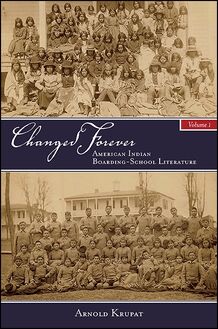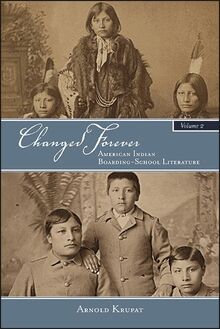Changed Forever, Volume II , livre ebook
249
pages
English
Ebooks
2020
Vous pourrez modifier la taille du texte de cet ouvrage
Obtenez un accès à la bibliothèque pour le consulter en ligne En savoir plus
Découvre YouScribe en t'inscrivant gratuitement
Découvre YouScribe en t'inscrivant gratuitement
249
pages
English
Ebooks
2020
Vous pourrez modifier la taille du texte de cet ouvrage
Obtenez un accès à la bibliothèque pour le consulter en ligne En savoir plus
Publié par
Date de parution
01 septembre 2020
Nombre de lectures
2
EAN13
9781438480084
Langue
English
Poids de l'ouvrage
1 Mo
List of Illustrations
Introduction
Part I: Dakota Boarding-School Autobiographies
1. Charles Eastman's From the Deep Woods to Civilization
2. Luther Standing Bear's My People, the Sioux
3. Zitkala-Sa's "Impressions of an Indian Childhood," "The School Days of an Indian Girl," and "An Indian Teacher among Indians"
4. Walter Littlemoon's They Called Me Uncivilized, Tim Giago's The Children Left Behind, Lydia Whirlwind Soldier's "Memories," and Mary Crow Dog's Lakota Woman
Part II: Ojibwe Boarding-School Autobiographies
5. John Rogers's Red World and White
6. George Morrison's Turning the Feather Around
7. Peter Razor's While the Locust Slept
8. Adam Fortunate Eagle's Pipestone: My Life in an Indian Boarding School, Dennis Banks's "Yellow Bus," and Jim Northrup's "FAMILIES—Nindanawemaaganag"
9. Edna Manitowabi's "An Ojibwa Girl in the City"
Part III: A Range of Boarding-School Autobiographies
10. Thomas Wildcat Alford's Civilization
11. Joe Blackbear's Jim Whitewolf: The Life of a Kiowa Apache Indian, and Carl Sweezy's The Arapaho Way: Memoir of an Indian Boyhood
12. Ah-nen-la-de-ni's "An Indian Boy's Story"
13. Esther Burnett Horne's Essie's Story
14. Viola Martinez, California Paiute: Living in Two Worlds
15. Reuben Snake's Your Humble Serpent
Appendix A: A Letter from Thomas Wildcat Alford, a Returned Student Formerly at Hampton Institute
Appendix B: Indian Boarding-School Students Mentioned in This Study, Vols. 1 and 2
Notes
Works Cited
Index
Publié par
Date de parution
01 septembre 2020
Nombre de lectures
2
EAN13
9781438480084
Langue
English
Poids de l'ouvrage
1 Mo
C HANGED F OREVER Volume II
SUNY series, Native Traces
Jace Weaver and Scott Richard Lyons, editors
Changed Forever
Volume II
A MERICAN I NDIAN B OARDING -S CHOOL L ITERATURE
Arnold Krupat
On the cover: Chauncey Yellow Robe (Timber), Henry Standing Bear, and Richard Yellow Robe (Wounded) at the time they entered Carlisle Indian School in 1883 and three years later, in 1886, both photographs taken by John N. Choate. Courtesy of Dickinson College Carlisle Indian School Project.
Published by State University of New York Press, Albany
© 2020 State University of New York
All rights reserved
Printed in the United States of America
No part of this book may be used or reproduced in any manner whatsoever without written permission. No part of this book may be stored in a retrieval system or transmitted in any form or by any means including electronic, electrostatic, magnetic tape, mechanical, photocopying, recording, or otherwise without the prior permission in writing of the publisher.
For information, contact State University of New York Press, Albany, NY
www.sunypress.edu
LIBRARY OF CONGRESS CATALOGING-IN-PUBLICATION DATA
Names: Krupat, Arnold, author.
Title: Changed forever: American Indian boarding-school literature. Volume II / Arnold Krupat. Other titles: American Indian boarding school literature
Description: Albany, NY : State University of New York Press, [2020] | Series: SUNY series, Native traces | Includes bibliographical references and index.
Identifiers: LCCN 2017022009 (print) | LCCN 2018005523 (ebook) | ISBN 9781438480084 (e-book) | ISBN 9781438480077 (hardcover : alk. paper)
Subjects: LCSH: Off-reservation boarding schools—United States—Biography. | Boarding school students—United States—Biography. | Indian students—United States—Biography. | Hopi Indians—Biography. | Navajo Indians—Biography. | Apache Indians—Biography. | Autobiographies—Indian authors.
Classification: LCC E97.5 (ebook) | LCC E97.5.K78 2018 (print) | DDC 371.829/97—dc23
LC record available at https://lccn.loc.gov/2017022009
10 9 8 7 6 5 4 3 2 1
For Gerald Vizenor
What has become of the thousands of Indian voices who spoke the breath of boarding-school life?
—K. Tsianina Lomawaima
We still know relatively little about how Indian school children themselves saw things.
—Michael Coleman
Boarding-school narratives have a significant place in the American Indian literary tradition.
—Amelia Katanski
CONTENTS
List of Illustrations
Introduction
P ART I D AKOTA B OARDING -S CHOOL A UTOBIOGRAPHIES
1 Charles Eastman’s From the Deep Woods to Civilization
2 Luther Standing Bear’s My People, the Sioux
3 Zitkala-Sa’s “Impressions of an Indian Childhood,” “The School Days of an Indian Girl,” and “An Indian Teacher among Indians”
4 Walter Littlemoon’s They Called Me Uncivilized , Tim Giago’s The Children Left Behind , Lydia Whirlwind Soldier’s “Memories,” and Mary Crow Dog’s Lakota Woman
P ART II O JIBWE B OARDING -S CHOOL A UTOBIOGRAPHIES
5 John Rogers’s Red World and White
6 George Morrison’s Turning the Feather Around
7 Peter Razor’s While the Locust Slept
8 Adam Fortunate Eagle’s Pipestone: My Life in an Indian Boarding School , Dennis Banks’s “Yellow Bus,” and Jim Northrup’s “ FAMILIES — Nindanawemaaganag ”
9 Edna Manitowabi’s “An Ojibwa Girl in the City”
P ART III. A R ANGE OF B OARDING -S CHOOL A UTOBIOGRAPHIES
10 Thomas Wildcat Alford’s Civilization
11 Joe Blackbear’s Jim Whitewolf: The Life of a Kiowa Apache Indian , and Carl Sweezy’s The Arapaho Way: Memoir of an Indian Boyhood
12 Ah-nen-la-de-ni’s “An Indian Boy’s Story”
13 Esther Burnett Horne’s Essie’s Story
14 Viola Martinez, California Paiute: Living in Two Worlds
15 Reuben Snake’s Your Humble Serpent
Appendix A A Letter from Thomas Wildcat Alford, a Returned Student Formerly at Hampton Institute
Appendix B Indian Boarding-School Students Mentioned in This Study, Vols. 1 and 2
Notes
Works Cited
Index
ILLUSTRATIONS
1 Superintendent Richard Pratt and Carlisle staff
2 Plenty Horses in 1891
3 Charles Alexander Eastman in 1897
4 Charles Alexander Eastman in 1913
5 Frontispiece of Stiya, a Carlisle Indian Girl at Home
6 Luther Standing Bear with his father
7 Spotted Tail’s delegation to Washington in 1880
8 The elder Standing Bear with his children and a friend at Carlisle
9 Dennison Wheelock, cornetist and conductor of the Carlisle Band, 1890
10 Zitkala-Sa in “traditional” dress
11 Zitkala-Sa with her violin
12 An Ojibwe chief outside a Medicine Lodge
13 Peter Razor in 2014
14 The first Indian graduates of the Hampton Institute in 1882
15 Joe Blackbear, Anadarko, Oklahoma, 1948
16 The Reverend H. R. Voth with a group of Arapaho girls
17 Carl Sweezy
18 Esther Burnett, about 1925
19 Reuben Snake, New York City, 1992
INTRODUCTION
FROM THE MOMENT THEY SET FOOT UPON THESE SHORES, THE EUROPEAN invader-settlers of America confronted an “Indian problem.” 1 This consisted of the simple fact that Indians occupied lands the newcomers wanted for themselves. To be sure, this was not the case for the earliest Spanish invaders of the Southeast and Southwest in the mid-sixteenth century, whose intent was to find treasure and to convert and missionize the tribal peoples they encountered. But in the Northeast, the English, from the early seventeenth century, and then the Americans, as they made their way across the continent, came to understand that broadly speaking, America’s Indian problem permitted only two solutions: extermination or education. Extermination was costly and dangerous, and in time it came to be thought wrong.
It then began to appear wiser, as the title of Robert Trennert’s introduction to a study of the Phoenix Indian School put the matter, for policymakers to proceed according to the assumption that “The Sword Will Give Way to the Spelling Book” (1988 3), thus offering—again to cite Trennert—an “alternative to extinction” (1975). Educating Native peoples—teaching them to speak, read, and write English; to convert to one or another version of Christianity; and to accept an individualism destructive of communal tribalism, ethnocide rather than genocide, was a strategy that might more efficiently and with fewer pangs to the national conscience free up Native landholdings and transform the American Indian into an Indian-American, uneasily inhabiting if not quite melted into the broad pot of the American mainstream.
In a fine 1969 study, Brewton Berry remarked that so far as the choice between “coercion” and “persuasion” was concerned (23), “Formal education has been regarded as the most effective means of bringing about assimilation” (22). In these respects, Trennert writes, when the Phoenix Indian School was founded in 1891, it was “for the specific purpose of preparing Native American children for assimilation … to remove Indian youngsters from their traditional environment, obliterate their cultural heritage, and replace that … with the values of white middle-class America.” Complicating the matter, he adds, was the fact that “the definition of assimilation was repeatedly revised between 1890 and 1930” (1988 xi). 2 Further complicating it well in to the 1960s and beyond was the fact that “white middle-class America” was not generally willing to accommodate persons of color regardless of whether they shared its values or not.
In the Annual Report of the Commissioner of Indian Affairs for 1890, the “Rules for Indian Schools” stated clearly that the government, in “organizing this system of schools,” intended them to “be preparatory and temporary; that eventually they will become unnecessary, and a full and free entrance be obtained for Indians into the public school system of the country. It is to this end,” the “Rules” continued, that “all officers and employees of the Indian school service should work” (in Bremner 1971, 2: 1354). Although Native Americans could obtain a “full and free entrance” to all public schools in the United States—as African Americans could not—on those occasions when they availed themselves of that right, they were not always welcomed or well served. Indeed, as Wilbert Ahern has written, “The local public schools to which 53% of Indian children went in 1925, were even less responsive to Indian communities than the BIA schools” (1996 88). And some of the Indian Office’s Catholic schools, from about the 1880s through the 1960s, as we will see, provided their own particular forms of disservice to their Native students.
In her study of the St. Joseph’s Indian boarding school in Kashena, Wisconsin, Sarah Shillinger affirms that “Assimilation was an important, if not a more important goal than education to the supporters of the boarding-school movement” (2008 95). Her conclusion, however, is that the boarding schools’ “results were closer to an integration of both cultural systems [Indian and white] than … to assimilation in

